University EYFS Assignment: Health, Safety, and Risk Management Report
VerifiedAdded on 2022/10/02
|7
|2060
|334
Report
AI Summary
This report examines health and safety practices within Early Years Foundation Stage (EYFS) childcare settings. It begins by outlining the legislative framework for health, safety, and risk management, referencing specific laws and initiatives in the UAE context, including the role of the Ministry of Interior and the Supreme Council for Motherhood & Childhood. The report then analyzes how policies, procedures, and practices in a specific childcare setting meet these requirements, detailing the risk assessment process, hazard identification, and control measures implemented. The responsibilities of employees, including supervision, hazard mitigation, and record-keeping, are also discussed. Furthermore, the report evaluates the effectiveness of risk management, emphasizing preparation, elicitation, verification, and gaining ownership of the process, including feedback from parents and staff. It also addresses the balance between risk and rights by providing training and information to co-workers. The report evaluates health and risk management policies and identifies areas needing improvement, such as staff turnover and parent involvement. Finally, it concludes by emphasizing the importance of practical and effective policies and procedures for child care services.
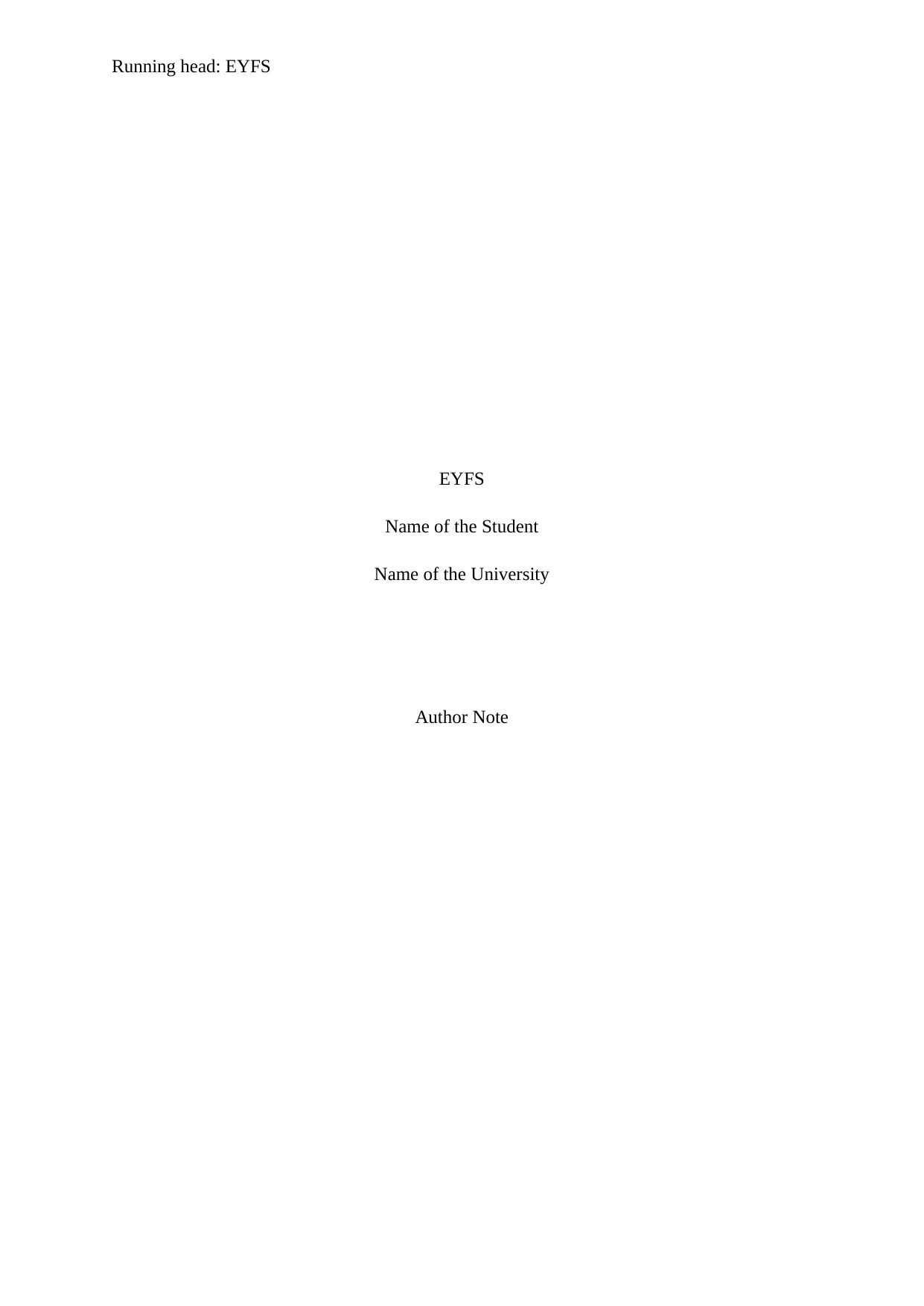
Running head: EYFS
EYFS
Name of the Student
Name of the University
Author Note
EYFS
Name of the Student
Name of the University
Author Note
Paraphrase This Document
Need a fresh take? Get an instant paraphrase of this document with our AI Paraphraser
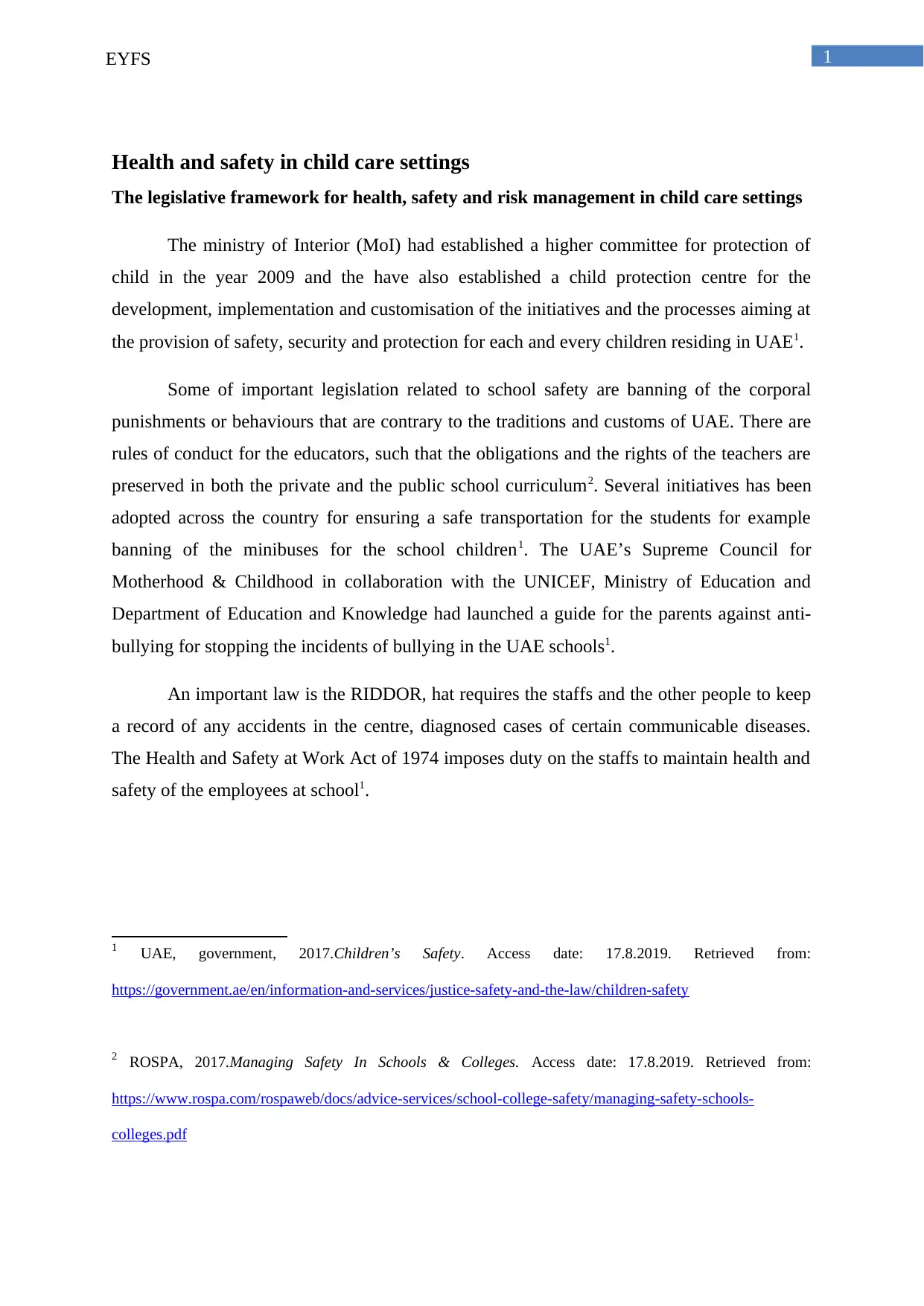
1EYFS
Health and safety in child care settings
The legislative framework for health, safety and risk management in child care settings
The ministry of Interior (MoI) had established a higher committee for protection of
child in the year 2009 and the have also established a child protection centre for the
development, implementation and customisation of the initiatives and the processes aiming at
the provision of safety, security and protection for each and every children residing in UAE1.
Some of important legislation related to school safety are banning of the corporal
punishments or behaviours that are contrary to the traditions and customs of UAE. There are
rules of conduct for the educators, such that the obligations and the rights of the teachers are
preserved in both the private and the public school curriculum2. Several initiatives has been
adopted across the country for ensuring a safe transportation for the students for example
banning of the minibuses for the school children1. The UAE’s Supreme Council for
Motherhood & Childhood in collaboration with the UNICEF, Ministry of Education and
Department of Education and Knowledge had launched a guide for the parents against anti-
bullying for stopping the incidents of bullying in the UAE schools1.
An important law is the RIDDOR, hat requires the staffs and the other people to keep
a record of any accidents in the centre, diagnosed cases of certain communicable diseases.
The Health and Safety at Work Act of 1974 imposes duty on the staffs to maintain health and
safety of the employees at school1.
1 UAE, government, 2017.Children’s Safety. Access date: 17.8.2019. Retrieved from:
https://government.ae/en/information-and-services/justice-safety-and-the-law/children-safety
2 ROSPA, 2017.Managing Safety In Schools & Colleges. Access date: 17.8.2019. Retrieved from:
https://www.rospa.com/rospaweb/docs/advice-services/school-college-safety/managing-safety-schools-
colleges.pdf
Health and safety in child care settings
The legislative framework for health, safety and risk management in child care settings
The ministry of Interior (MoI) had established a higher committee for protection of
child in the year 2009 and the have also established a child protection centre for the
development, implementation and customisation of the initiatives and the processes aiming at
the provision of safety, security and protection for each and every children residing in UAE1.
Some of important legislation related to school safety are banning of the corporal
punishments or behaviours that are contrary to the traditions and customs of UAE. There are
rules of conduct for the educators, such that the obligations and the rights of the teachers are
preserved in both the private and the public school curriculum2. Several initiatives has been
adopted across the country for ensuring a safe transportation for the students for example
banning of the minibuses for the school children1. The UAE’s Supreme Council for
Motherhood & Childhood in collaboration with the UNICEF, Ministry of Education and
Department of Education and Knowledge had launched a guide for the parents against anti-
bullying for stopping the incidents of bullying in the UAE schools1.
An important law is the RIDDOR, hat requires the staffs and the other people to keep
a record of any accidents in the centre, diagnosed cases of certain communicable diseases.
The Health and Safety at Work Act of 1974 imposes duty on the staffs to maintain health and
safety of the employees at school1.
1 UAE, government, 2017.Children’s Safety. Access date: 17.8.2019. Retrieved from:
https://government.ae/en/information-and-services/justice-safety-and-the-law/children-safety
2 ROSPA, 2017.Managing Safety In Schools & Colleges. Access date: 17.8.2019. Retrieved from:
https://www.rospa.com/rospaweb/docs/advice-services/school-college-safety/managing-safety-schools-
colleges.pdf
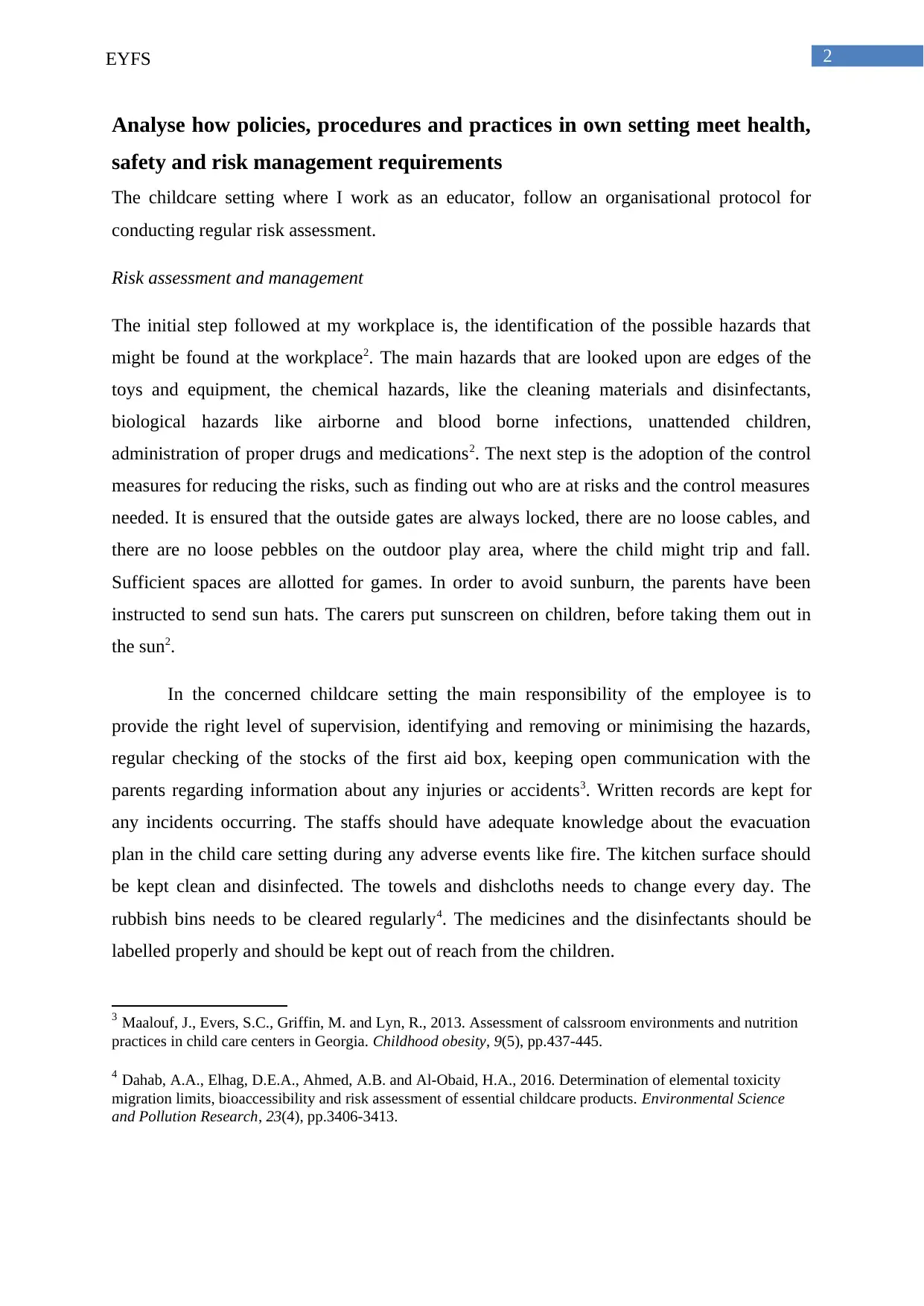
2EYFS
Analyse how policies, procedures and practices in own setting meet health,
safety and risk management requirements
The childcare setting where I work as an educator, follow an organisational protocol for
conducting regular risk assessment.
Risk assessment and management
The initial step followed at my workplace is, the identification of the possible hazards that
might be found at the workplace2. The main hazards that are looked upon are edges of the
toys and equipment, the chemical hazards, like the cleaning materials and disinfectants,
biological hazards like airborne and blood borne infections, unattended children,
administration of proper drugs and medications2. The next step is the adoption of the control
measures for reducing the risks, such as finding out who are at risks and the control measures
needed. It is ensured that the outside gates are always locked, there are no loose cables, and
there are no loose pebbles on the outdoor play area, where the child might trip and fall.
Sufficient spaces are allotted for games. In order to avoid sunburn, the parents have been
instructed to send sun hats. The carers put sunscreen on children, before taking them out in
the sun2.
In the concerned childcare setting the main responsibility of the employee is to
provide the right level of supervision, identifying and removing or minimising the hazards,
regular checking of the stocks of the first aid box, keeping open communication with the
parents regarding information about any injuries or accidents3. Written records are kept for
any incidents occurring. The staffs should have adequate knowledge about the evacuation
plan in the child care setting during any adverse events like fire. The kitchen surface should
be kept clean and disinfected. The towels and dishcloths needs to change every day. The
rubbish bins needs to be cleared regularly4. The medicines and the disinfectants should be
labelled properly and should be kept out of reach from the children.
3 Maalouf, J., Evers, S.C., Griffin, M. and Lyn, R., 2013. Assessment of calssroom environments and nutrition
practices in child care centers in Georgia. Childhood obesity, 9(5), pp.437-445.
4 Dahab, A.A., Elhag, D.E.A., Ahmed, A.B. and Al-Obaid, H.A., 2016. Determination of elemental toxicity
migration limits, bioaccessibility and risk assessment of essential childcare products. Environmental Science
and Pollution Research, 23(4), pp.3406-3413.
Analyse how policies, procedures and practices in own setting meet health,
safety and risk management requirements
The childcare setting where I work as an educator, follow an organisational protocol for
conducting regular risk assessment.
Risk assessment and management
The initial step followed at my workplace is, the identification of the possible hazards that
might be found at the workplace2. The main hazards that are looked upon are edges of the
toys and equipment, the chemical hazards, like the cleaning materials and disinfectants,
biological hazards like airborne and blood borne infections, unattended children,
administration of proper drugs and medications2. The next step is the adoption of the control
measures for reducing the risks, such as finding out who are at risks and the control measures
needed. It is ensured that the outside gates are always locked, there are no loose cables, and
there are no loose pebbles on the outdoor play area, where the child might trip and fall.
Sufficient spaces are allotted for games. In order to avoid sunburn, the parents have been
instructed to send sun hats. The carers put sunscreen on children, before taking them out in
the sun2.
In the concerned childcare setting the main responsibility of the employee is to
provide the right level of supervision, identifying and removing or minimising the hazards,
regular checking of the stocks of the first aid box, keeping open communication with the
parents regarding information about any injuries or accidents3. Written records are kept for
any incidents occurring. The staffs should have adequate knowledge about the evacuation
plan in the child care setting during any adverse events like fire. The kitchen surface should
be kept clean and disinfected. The towels and dishcloths needs to change every day. The
rubbish bins needs to be cleared regularly4. The medicines and the disinfectants should be
labelled properly and should be kept out of reach from the children.
3 Maalouf, J., Evers, S.C., Griffin, M. and Lyn, R., 2013. Assessment of calssroom environments and nutrition
practices in child care centers in Georgia. Childhood obesity, 9(5), pp.437-445.
4 Dahab, A.A., Elhag, D.E.A., Ahmed, A.B. and Al-Obaid, H.A., 2016. Determination of elemental toxicity
migration limits, bioaccessibility and risk assessment of essential childcare products. Environmental Science
and Pollution Research, 23(4), pp.3406-3413.
⊘ This is a preview!⊘
Do you want full access?
Subscribe today to unlock all pages.

Trusted by 1+ million students worldwide
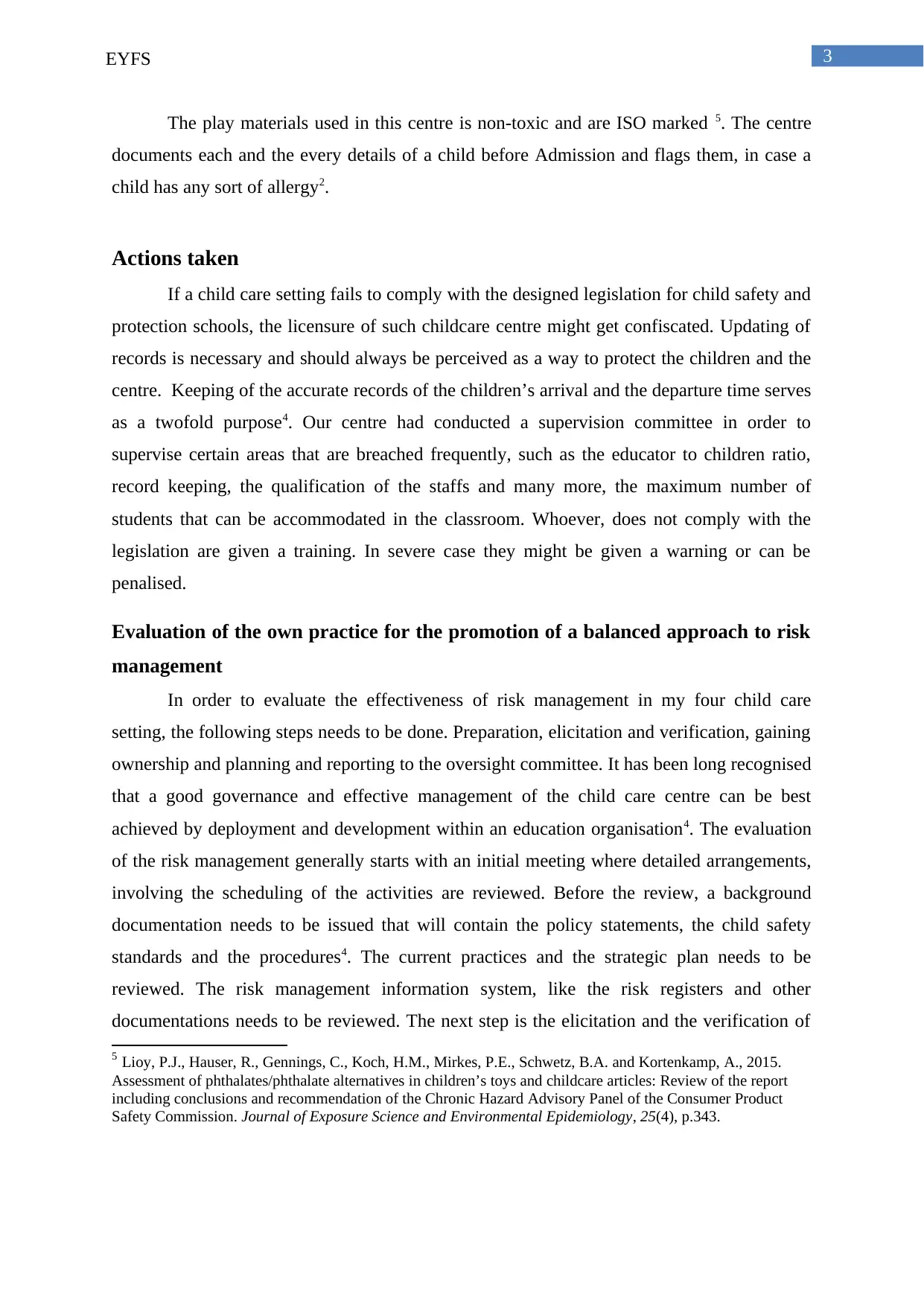
3EYFS
The play materials used in this centre is non-toxic and are ISO marked 5. The centre
documents each and the every details of a child before Admission and flags them, in case a
child has any sort of allergy2.
Actions taken
If a child care setting fails to comply with the designed legislation for child safety and
protection schools, the licensure of such childcare centre might get confiscated. Updating of
records is necessary and should always be perceived as a way to protect the children and the
centre. Keeping of the accurate records of the children’s arrival and the departure time serves
as a twofold purpose4. Our centre had conducted a supervision committee in order to
supervise certain areas that are breached frequently, such as the educator to children ratio,
record keeping, the qualification of the staffs and many more, the maximum number of
students that can be accommodated in the classroom. Whoever, does not comply with the
legislation are given a training. In severe case they might be given a warning or can be
penalised.
Evaluation of the own practice for the promotion of a balanced approach to risk
management
In order to evaluate the effectiveness of risk management in my four child care
setting, the following steps needs to be done. Preparation, elicitation and verification, gaining
ownership and planning and reporting to the oversight committee. It has been long recognised
that a good governance and effective management of the child care centre can be best
achieved by deployment and development within an education organisation4. The evaluation
of the risk management generally starts with an initial meeting where detailed arrangements,
involving the scheduling of the activities are reviewed. Before the review, a background
documentation needs to be issued that will contain the policy statements, the child safety
standards and the procedures4. The current practices and the strategic plan needs to be
reviewed. The risk management information system, like the risk registers and other
documentations needs to be reviewed. The next step is the elicitation and the verification of
5 Lioy, P.J., Hauser, R., Gennings, C., Koch, H.M., Mirkes, P.E., Schwetz, B.A. and Kortenkamp, A., 2015.
Assessment of phthalates/phthalate alternatives in children’s toys and childcare articles: Review of the report
including conclusions and recommendation of the Chronic Hazard Advisory Panel of the Consumer Product
Safety Commission. Journal of Exposure Science and Environmental Epidemiology, 25(4), p.343.
The play materials used in this centre is non-toxic and are ISO marked 5. The centre
documents each and the every details of a child before Admission and flags them, in case a
child has any sort of allergy2.
Actions taken
If a child care setting fails to comply with the designed legislation for child safety and
protection schools, the licensure of such childcare centre might get confiscated. Updating of
records is necessary and should always be perceived as a way to protect the children and the
centre. Keeping of the accurate records of the children’s arrival and the departure time serves
as a twofold purpose4. Our centre had conducted a supervision committee in order to
supervise certain areas that are breached frequently, such as the educator to children ratio,
record keeping, the qualification of the staffs and many more, the maximum number of
students that can be accommodated in the classroom. Whoever, does not comply with the
legislation are given a training. In severe case they might be given a warning or can be
penalised.
Evaluation of the own practice for the promotion of a balanced approach to risk
management
In order to evaluate the effectiveness of risk management in my four child care
setting, the following steps needs to be done. Preparation, elicitation and verification, gaining
ownership and planning and reporting to the oversight committee. It has been long recognised
that a good governance and effective management of the child care centre can be best
achieved by deployment and development within an education organisation4. The evaluation
of the risk management generally starts with an initial meeting where detailed arrangements,
involving the scheduling of the activities are reviewed. Before the review, a background
documentation needs to be issued that will contain the policy statements, the child safety
standards and the procedures4. The current practices and the strategic plan needs to be
reviewed. The risk management information system, like the risk registers and other
documentations needs to be reviewed. The next step is the elicitation and the verification of
5 Lioy, P.J., Hauser, R., Gennings, C., Koch, H.M., Mirkes, P.E., Schwetz, B.A. and Kortenkamp, A., 2015.
Assessment of phthalates/phthalate alternatives in children’s toys and childcare articles: Review of the report
including conclusions and recommendation of the Chronic Hazard Advisory Panel of the Consumer Product
Safety Commission. Journal of Exposure Science and Environmental Epidemiology, 25(4), p.343.
Paraphrase This Document
Need a fresh take? Get an instant paraphrase of this document with our AI Paraphraser
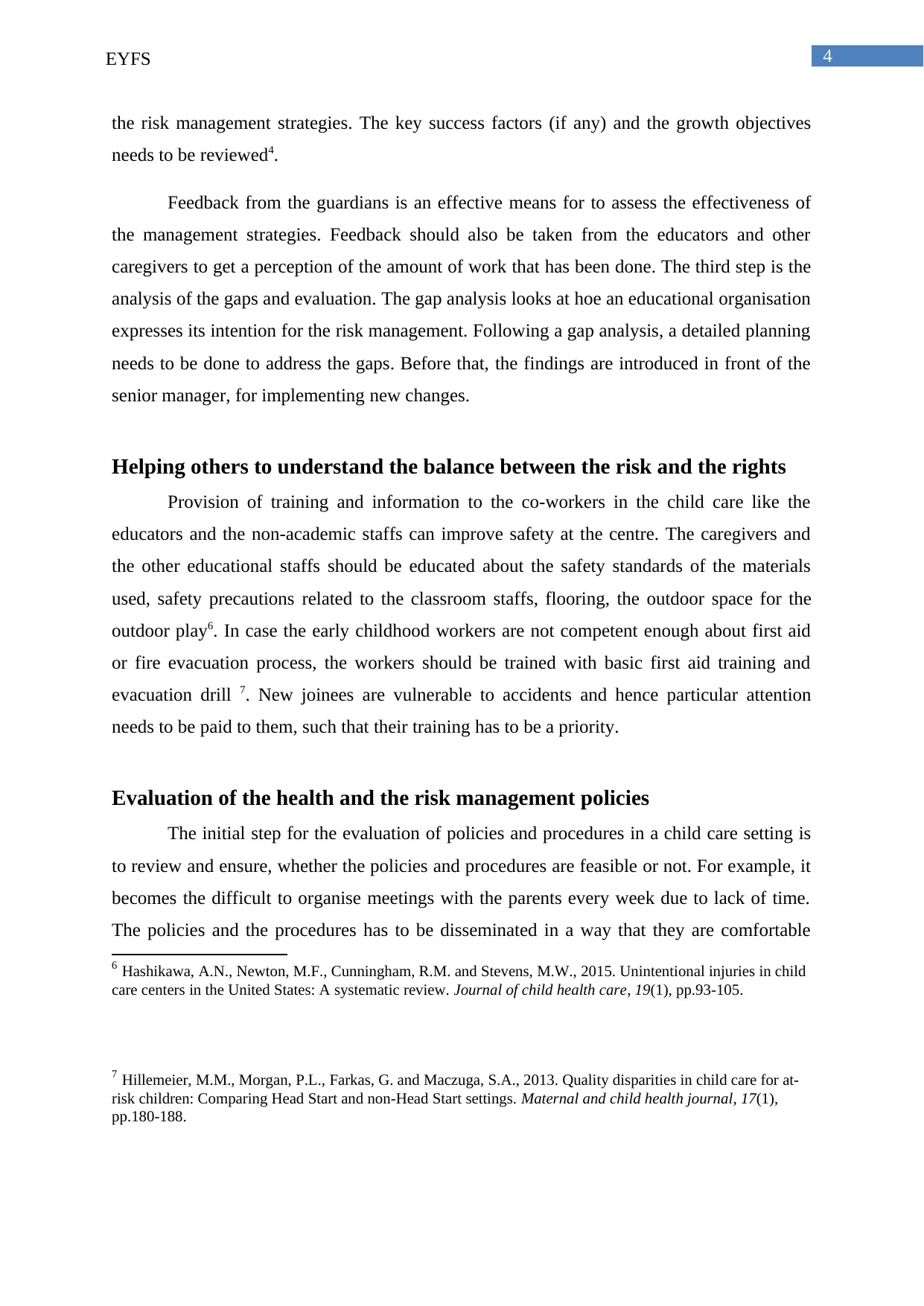
4EYFS
the risk management strategies. The key success factors (if any) and the growth objectives
needs to be reviewed4.
Feedback from the guardians is an effective means for to assess the effectiveness of
the management strategies. Feedback should also be taken from the educators and other
caregivers to get a perception of the amount of work that has been done. The third step is the
analysis of the gaps and evaluation. The gap analysis looks at hoe an educational organisation
expresses its intention for the risk management. Following a gap analysis, a detailed planning
needs to be done to address the gaps. Before that, the findings are introduced in front of the
senior manager, for implementing new changes.
Helping others to understand the balance between the risk and the rights
Provision of training and information to the co-workers in the child care like the
educators and the non-academic staffs can improve safety at the centre. The caregivers and
the other educational staffs should be educated about the safety standards of the materials
used, safety precautions related to the classroom staffs, flooring, the outdoor space for the
outdoor play6. In case the early childhood workers are not competent enough about first aid
or fire evacuation process, the workers should be trained with basic first aid training and
evacuation drill 7. New joinees are vulnerable to accidents and hence particular attention
needs to be paid to them, such that their training has to be a priority.
Evaluation of the health and the risk management policies
The initial step for the evaluation of policies and procedures in a child care setting is
to review and ensure, whether the policies and procedures are feasible or not. For example, it
becomes the difficult to organise meetings with the parents every week due to lack of time.
The policies and the procedures has to be disseminated in a way that they are comfortable
6 Hashikawa, A.N., Newton, M.F., Cunningham, R.M. and Stevens, M.W., 2015. Unintentional injuries in child
care centers in the United States: A systematic review. Journal of child health care, 19(1), pp.93-105.
7 Hillemeier, M.M., Morgan, P.L., Farkas, G. and Maczuga, S.A., 2013. Quality disparities in child care for at-
risk children: Comparing Head Start and non-Head Start settings. Maternal and child health journal, 17(1),
pp.180-188.
the risk management strategies. The key success factors (if any) and the growth objectives
needs to be reviewed4.
Feedback from the guardians is an effective means for to assess the effectiveness of
the management strategies. Feedback should also be taken from the educators and other
caregivers to get a perception of the amount of work that has been done. The third step is the
analysis of the gaps and evaluation. The gap analysis looks at hoe an educational organisation
expresses its intention for the risk management. Following a gap analysis, a detailed planning
needs to be done to address the gaps. Before that, the findings are introduced in front of the
senior manager, for implementing new changes.
Helping others to understand the balance between the risk and the rights
Provision of training and information to the co-workers in the child care like the
educators and the non-academic staffs can improve safety at the centre. The caregivers and
the other educational staffs should be educated about the safety standards of the materials
used, safety precautions related to the classroom staffs, flooring, the outdoor space for the
outdoor play6. In case the early childhood workers are not competent enough about first aid
or fire evacuation process, the workers should be trained with basic first aid training and
evacuation drill 7. New joinees are vulnerable to accidents and hence particular attention
needs to be paid to them, such that their training has to be a priority.
Evaluation of the health and the risk management policies
The initial step for the evaluation of policies and procedures in a child care setting is
to review and ensure, whether the policies and procedures are feasible or not. For example, it
becomes the difficult to organise meetings with the parents every week due to lack of time.
The policies and the procedures has to be disseminated in a way that they are comfortable
6 Hashikawa, A.N., Newton, M.F., Cunningham, R.M. and Stevens, M.W., 2015. Unintentional injuries in child
care centers in the United States: A systematic review. Journal of child health care, 19(1), pp.93-105.
7 Hillemeier, M.M., Morgan, P.L., Farkas, G. and Maczuga, S.A., 2013. Quality disparities in child care for at-
risk children: Comparing Head Start and non-Head Start settings. Maternal and child health journal, 17(1),
pp.180-188.
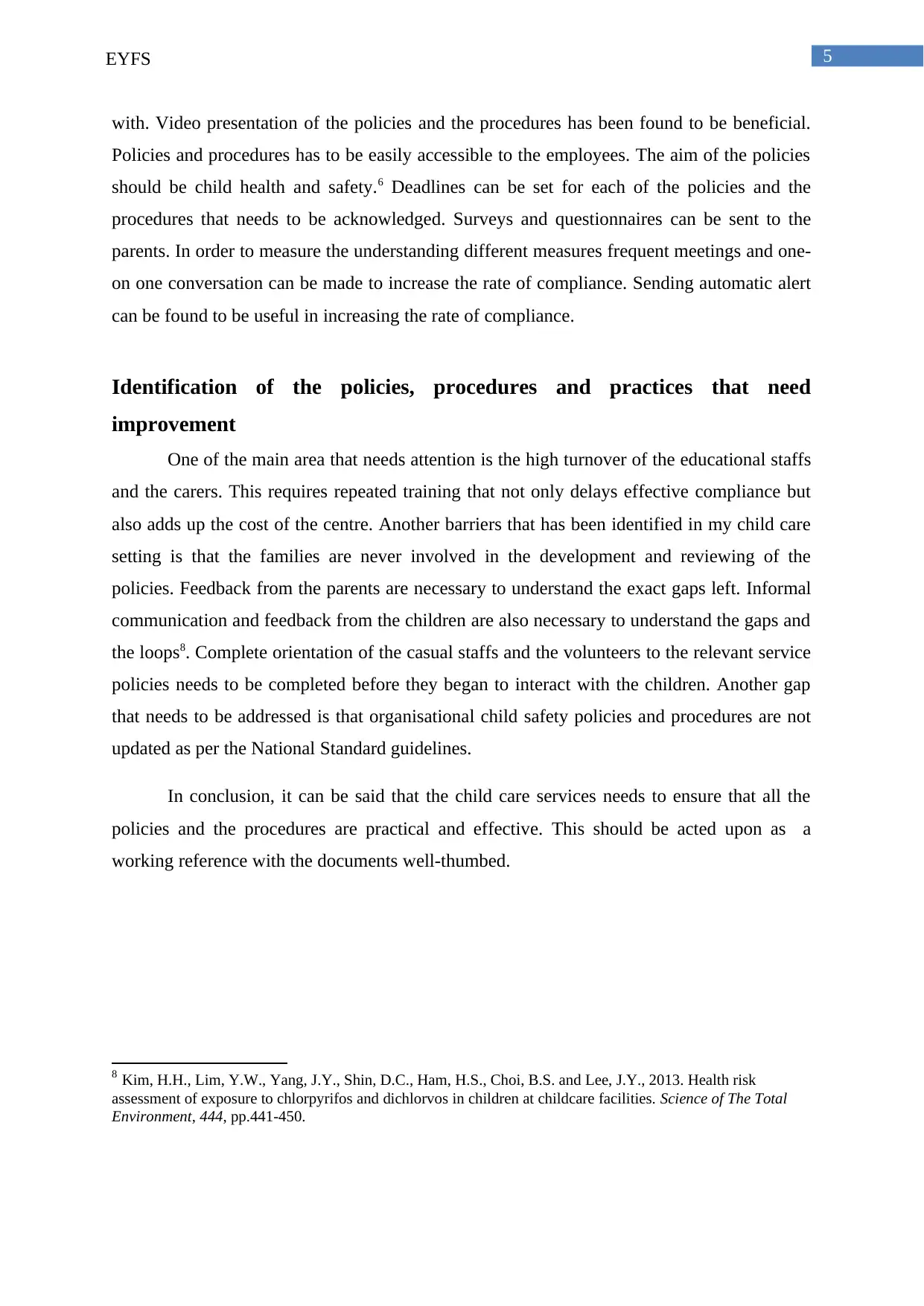
5EYFS
with. Video presentation of the policies and the procedures has been found to be beneficial.
Policies and procedures has to be easily accessible to the employees. The aim of the policies
should be child health and safety.6 Deadlines can be set for each of the policies and the
procedures that needs to be acknowledged. Surveys and questionnaires can be sent to the
parents. In order to measure the understanding different measures frequent meetings and one-
on one conversation can be made to increase the rate of compliance. Sending automatic alert
can be found to be useful in increasing the rate of compliance.
Identification of the policies, procedures and practices that need
improvement
One of the main area that needs attention is the high turnover of the educational staffs
and the carers. This requires repeated training that not only delays effective compliance but
also adds up the cost of the centre. Another barriers that has been identified in my child care
setting is that the families are never involved in the development and reviewing of the
policies. Feedback from the parents are necessary to understand the exact gaps left. Informal
communication and feedback from the children are also necessary to understand the gaps and
the loops8. Complete orientation of the casual staffs and the volunteers to the relevant service
policies needs to be completed before they began to interact with the children. Another gap
that needs to be addressed is that organisational child safety policies and procedures are not
updated as per the National Standard guidelines.
In conclusion, it can be said that the child care services needs to ensure that all the
policies and the procedures are practical and effective. This should be acted upon as a
working reference with the documents well-thumbed.
8 Kim, H.H., Lim, Y.W., Yang, J.Y., Shin, D.C., Ham, H.S., Choi, B.S. and Lee, J.Y., 2013. Health risk
assessment of exposure to chlorpyrifos and dichlorvos in children at childcare facilities. Science of The Total
Environment, 444, pp.441-450.
with. Video presentation of the policies and the procedures has been found to be beneficial.
Policies and procedures has to be easily accessible to the employees. The aim of the policies
should be child health and safety.6 Deadlines can be set for each of the policies and the
procedures that needs to be acknowledged. Surveys and questionnaires can be sent to the
parents. In order to measure the understanding different measures frequent meetings and one-
on one conversation can be made to increase the rate of compliance. Sending automatic alert
can be found to be useful in increasing the rate of compliance.
Identification of the policies, procedures and practices that need
improvement
One of the main area that needs attention is the high turnover of the educational staffs
and the carers. This requires repeated training that not only delays effective compliance but
also adds up the cost of the centre. Another barriers that has been identified in my child care
setting is that the families are never involved in the development and reviewing of the
policies. Feedback from the parents are necessary to understand the exact gaps left. Informal
communication and feedback from the children are also necessary to understand the gaps and
the loops8. Complete orientation of the casual staffs and the volunteers to the relevant service
policies needs to be completed before they began to interact with the children. Another gap
that needs to be addressed is that organisational child safety policies and procedures are not
updated as per the National Standard guidelines.
In conclusion, it can be said that the child care services needs to ensure that all the
policies and the procedures are practical and effective. This should be acted upon as a
working reference with the documents well-thumbed.
8 Kim, H.H., Lim, Y.W., Yang, J.Y., Shin, D.C., Ham, H.S., Choi, B.S. and Lee, J.Y., 2013. Health risk
assessment of exposure to chlorpyrifos and dichlorvos in children at childcare facilities. Science of The Total
Environment, 444, pp.441-450.
⊘ This is a preview!⊘
Do you want full access?
Subscribe today to unlock all pages.

Trusted by 1+ million students worldwide
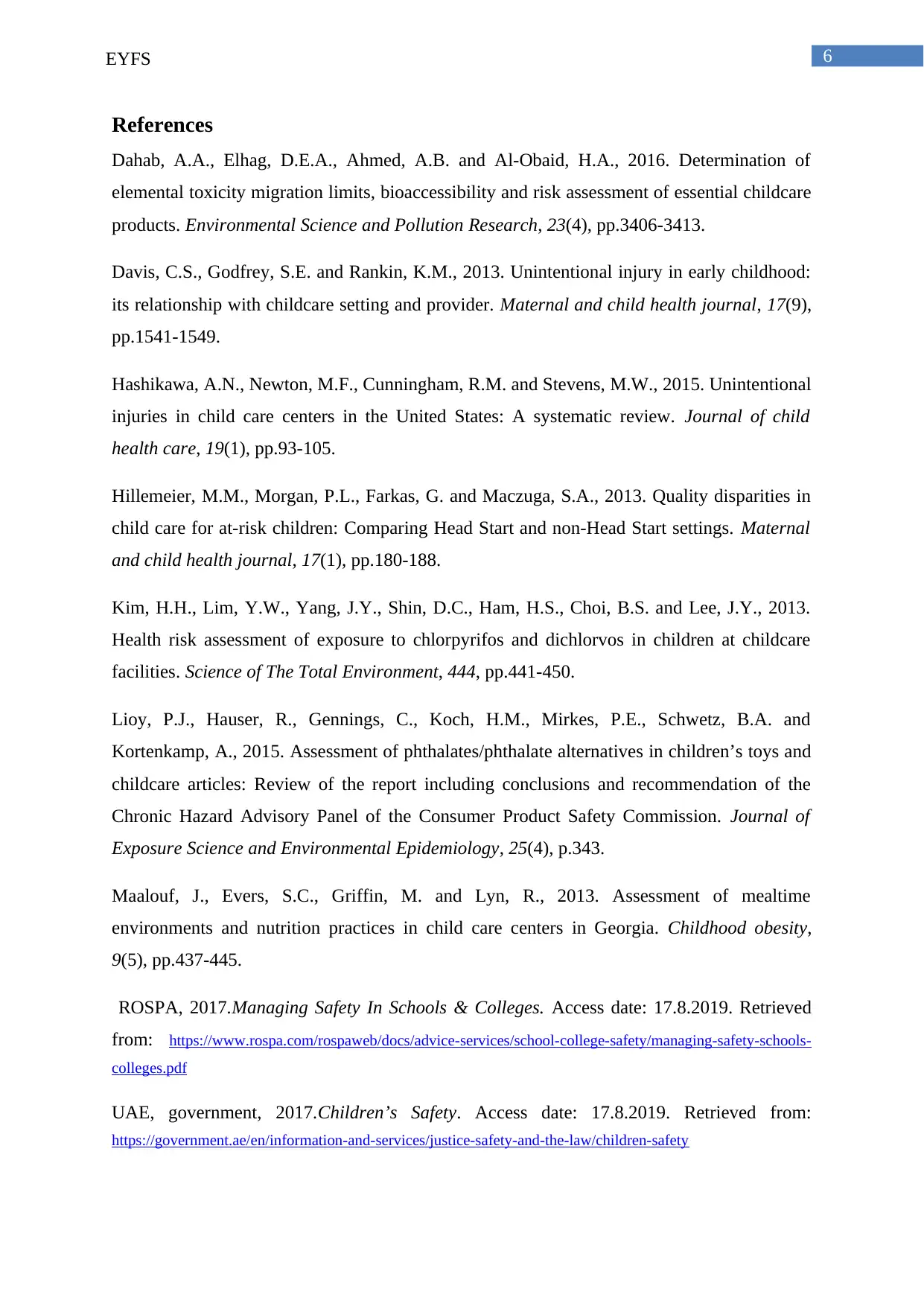
6EYFS
References
Dahab, A.A., Elhag, D.E.A., Ahmed, A.B. and Al-Obaid, H.A., 2016. Determination of
elemental toxicity migration limits, bioaccessibility and risk assessment of essential childcare
products. Environmental Science and Pollution Research, 23(4), pp.3406-3413.
Davis, C.S., Godfrey, S.E. and Rankin, K.M., 2013. Unintentional injury in early childhood:
its relationship with childcare setting and provider. Maternal and child health journal, 17(9),
pp.1541-1549.
Hashikawa, A.N., Newton, M.F., Cunningham, R.M. and Stevens, M.W., 2015. Unintentional
injuries in child care centers in the United States: A systematic review. Journal of child
health care, 19(1), pp.93-105.
Hillemeier, M.M., Morgan, P.L., Farkas, G. and Maczuga, S.A., 2013. Quality disparities in
child care for at-risk children: Comparing Head Start and non-Head Start settings. Maternal
and child health journal, 17(1), pp.180-188.
Kim, H.H., Lim, Y.W., Yang, J.Y., Shin, D.C., Ham, H.S., Choi, B.S. and Lee, J.Y., 2013.
Health risk assessment of exposure to chlorpyrifos and dichlorvos in children at childcare
facilities. Science of The Total Environment, 444, pp.441-450.
Lioy, P.J., Hauser, R., Gennings, C., Koch, H.M., Mirkes, P.E., Schwetz, B.A. and
Kortenkamp, A., 2015. Assessment of phthalates/phthalate alternatives in children’s toys and
childcare articles: Review of the report including conclusions and recommendation of the
Chronic Hazard Advisory Panel of the Consumer Product Safety Commission. Journal of
Exposure Science and Environmental Epidemiology, 25(4), p.343.
Maalouf, J., Evers, S.C., Griffin, M. and Lyn, R., 2013. Assessment of mealtime
environments and nutrition practices in child care centers in Georgia. Childhood obesity,
9(5), pp.437-445.
ROSPA, 2017.Managing Safety In Schools & Colleges. Access date: 17.8.2019. Retrieved
from: https://www.rospa.com/rospaweb/docs/advice-services/school-college-safety/managing-safety-schools-
colleges.pdf
UAE, government, 2017.Children’s Safety. Access date: 17.8.2019. Retrieved from:
https://government.ae/en/information-and-services/justice-safety-and-the-law/children-safety
References
Dahab, A.A., Elhag, D.E.A., Ahmed, A.B. and Al-Obaid, H.A., 2016. Determination of
elemental toxicity migration limits, bioaccessibility and risk assessment of essential childcare
products. Environmental Science and Pollution Research, 23(4), pp.3406-3413.
Davis, C.S., Godfrey, S.E. and Rankin, K.M., 2013. Unintentional injury in early childhood:
its relationship with childcare setting and provider. Maternal and child health journal, 17(9),
pp.1541-1549.
Hashikawa, A.N., Newton, M.F., Cunningham, R.M. and Stevens, M.W., 2015. Unintentional
injuries in child care centers in the United States: A systematic review. Journal of child
health care, 19(1), pp.93-105.
Hillemeier, M.M., Morgan, P.L., Farkas, G. and Maczuga, S.A., 2013. Quality disparities in
child care for at-risk children: Comparing Head Start and non-Head Start settings. Maternal
and child health journal, 17(1), pp.180-188.
Kim, H.H., Lim, Y.W., Yang, J.Y., Shin, D.C., Ham, H.S., Choi, B.S. and Lee, J.Y., 2013.
Health risk assessment of exposure to chlorpyrifos and dichlorvos in children at childcare
facilities. Science of The Total Environment, 444, pp.441-450.
Lioy, P.J., Hauser, R., Gennings, C., Koch, H.M., Mirkes, P.E., Schwetz, B.A. and
Kortenkamp, A., 2015. Assessment of phthalates/phthalate alternatives in children’s toys and
childcare articles: Review of the report including conclusions and recommendation of the
Chronic Hazard Advisory Panel of the Consumer Product Safety Commission. Journal of
Exposure Science and Environmental Epidemiology, 25(4), p.343.
Maalouf, J., Evers, S.C., Griffin, M. and Lyn, R., 2013. Assessment of mealtime
environments and nutrition practices in child care centers in Georgia. Childhood obesity,
9(5), pp.437-445.
ROSPA, 2017.Managing Safety In Schools & Colleges. Access date: 17.8.2019. Retrieved
from: https://www.rospa.com/rospaweb/docs/advice-services/school-college-safety/managing-safety-schools-
colleges.pdf
UAE, government, 2017.Children’s Safety. Access date: 17.8.2019. Retrieved from:
https://government.ae/en/information-and-services/justice-safety-and-the-law/children-safety
1 out of 7
Related Documents
Your All-in-One AI-Powered Toolkit for Academic Success.
+13062052269
info@desklib.com
Available 24*7 on WhatsApp / Email
![[object Object]](/_next/static/media/star-bottom.7253800d.svg)
Unlock your academic potential
Copyright © 2020–2025 A2Z Services. All Rights Reserved. Developed and managed by ZUCOL.




